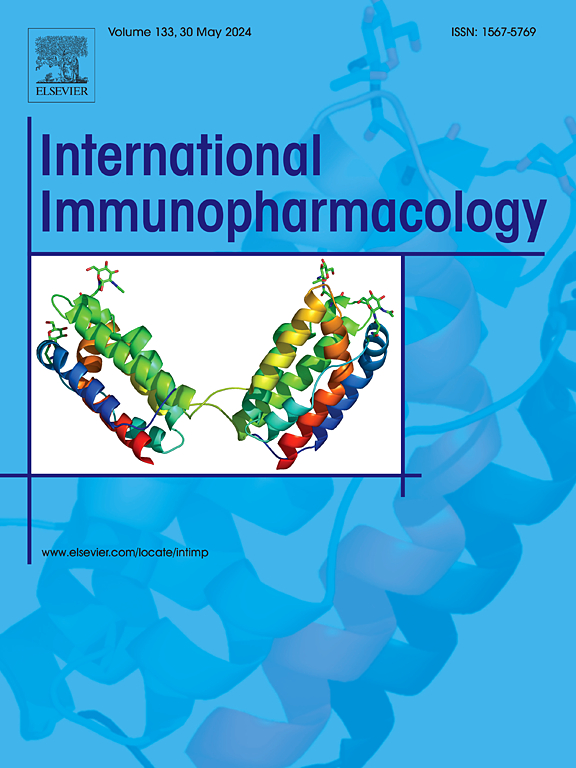海洋真菌代谢物 MHO7 通过靶向膜磷脂酰乙醇胺促进胶质母细胞瘤细胞凋亡,是一种新型 Akt 抑制剂
IF 4.7
2区 医学
Q2 IMMUNOLOGY
引用次数: 0
摘要
替莫唑胺(TMZ)耐药是胶质母细胞瘤(GBM)治疗的主要挑战。海洋衍生的真菌代谢物是潜在化疗候选药物的重要来源。本研究旨在探讨MHO7 (6-epi-ophiobolin G)对GBM细胞的细胞毒作用。MHO7抑制GBM细胞增殖,促进细胞凋亡,同时降低Akt活性和膜磷脂酰肌醇4,5-二磷酸(PIP2)和磷脂酰肌醇3,4,5-三磷酸(PIP3)含量。我们证实MHO7可以与磷脂酰乙醇胺(PE)反应形成共价加合物,PE是质膜中含量第二丰富的磷脂。外源性PE预孵育显著减轻MHO7的促凋亡作用,同时Akt活性和膜PIP2和PIP3含量升高。由于与PIP3结合是Akt激活的关键步骤,我们的研究结果表明MHO7可以作为一种新的Akt抑制剂发挥作用。此外,MHO7与TMZ具有协同促凋亡作用,并且TMZ耐药的GBM细胞对MHO7仍然敏感。MHO7对正常神经元细胞无明显细胞毒性。在原位胶质瘤小鼠模型中也观察到MHO7的抗生长作用。因此,MHO7是一种很有前景的GBM化疗药物。本研究也提示膜脂靶向治疗可能是一种新的有效的肿瘤治疗策略。本文章由计算机程序翻译,如有差异,请以英文原文为准。

Marine-derived fungal metabolite MHO7 promotes glioblastoma cell apoptosis as a novel Akt inhibitor by targeting membrane phosphatidylethanolamine
Temozolomide (TMZ) chemoresistance is a major challenge in the management of glioblastoma (GBM). Marine-derived fungal metabolites are a significant source of potential chemotherapeutic candidates. This study aimed to investigate the cytotoxic effect of MHO7 (6-epi-ophiobolin G) on GBM cells. MHO7 inhibited GBM cell proliferation and promoted apoptosis, accompanied by a reduction in Akt activity and membrane phosphatidylinositol 4,5-bisphosphate (PIP2) and phosphatidylinositol 3,4,5-trisphosphate (PIP3) content. We verified that MHO7 could react with phosphatidylethanolamine (PE), the second most abundant phospholipid in the plasma membrane, to form a covalent adduct. Pre-incubation with exogenous PE significantly alleviated the pro-apoptotic effect of MHO7, with a concomitant increase in Akt activity and membrane PIP2 and PIP3 content. Since binding to PIP3 is a key step in Akt activation, our results indicate that MHO7 can function as a novel Akt inhibitor. Additionally, MHO7 has a synergistic pro-apoptotic effect with TMZ, and TMZ-resistant GBM cells remain sensitive to MHO7. MHO7 had little cytotoxicity against normal neuronal cells. The anti-growth effect of MHO7 was also observed in an orthotopic glioma mice model. Therefore, MHO7 is a promising chemotherapeutic agent for GBM. This study also indicated that membrane lipid-targeted therapy may be a novel and effective strategy for tumor treatment.
求助全文
通过发布文献求助,成功后即可免费获取论文全文。
去求助
来源期刊
CiteScore
8.40
自引率
3.60%
发文量
935
审稿时长
53 days
期刊介绍:
International Immunopharmacology is the primary vehicle for the publication of original research papers pertinent to the overlapping areas of immunology, pharmacology, cytokine biology, immunotherapy, immunopathology and immunotoxicology. Review articles that encompass these subjects are also welcome.
The subject material appropriate for submission includes:
• Clinical studies employing immunotherapy of any type including the use of: bacterial and chemical agents; thymic hormones, interferon, lymphokines, etc., in transplantation and diseases such as cancer, immunodeficiency, chronic infection and allergic, inflammatory or autoimmune disorders.
• Studies on the mechanisms of action of these agents for specific parameters of immune competence as well as the overall clinical state.
• Pre-clinical animal studies and in vitro studies on mechanisms of action with immunopotentiators, immunomodulators, immunoadjuvants and other pharmacological agents active on cells participating in immune or allergic responses.
• Pharmacological compounds, microbial products and toxicological agents that affect the lymphoid system, and their mechanisms of action.
• Agents that activate genes or modify transcription and translation within the immune response.
• Substances activated, generated, or released through immunologic or related pathways that are pharmacologically active.
• Production, function and regulation of cytokines and their receptors.
• Classical pharmacological studies on the effects of chemokines and bioactive factors released during immunological reactions.

 求助内容:
求助内容: 应助结果提醒方式:
应助结果提醒方式:


